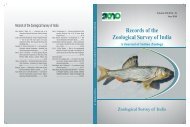Vol. 111 - Part I - Zoological Survey of India
Vol. 111 - Part I - Zoological Survey of India
Vol. 111 - Part I - Zoological Survey of India
You also want an ePaper? Increase the reach of your titles
YUMPU automatically turns print PDFs into web optimized ePapers that Google loves.
40 Rec. zool. Surv. <strong>India</strong><br />
Apart from many wild animals there is a good<br />
population <strong>of</strong> dogs, inside the club in the central<br />
constructed area, who are enjoying the protection from<br />
club authorities, and acting as guard against the<br />
surrounding jackal population mostly confined to<br />
northern and southern part <strong>of</strong> the club.<br />
THE GOLDEN JACKAL (Canis aureus)<br />
a) Distribution<br />
The Golden Jackal also called Asiatic, Oriental or<br />
Common Jackal are native to north and east Africa,<br />
southeastern Europe and south Asia up to Mayanmar.<br />
It is the largest <strong>of</strong> the jackals with three <strong>India</strong>n<br />
subspecies recognized. In <strong>India</strong>, they are found almost<br />
throughout the country (Alfred et al. 2006).<br />
b) Morphology<br />
The Golden Jackal’s short, coarse fur is usually<br />
yellow to pale golden and brown-tipped, though the<br />
color may vary with season and region. The underside,<br />
throat and areas around eyes and lips have whitish<br />
hair. The Golden Jackal is generally 71-107 cm. in length,<br />
with a tail length <strong>of</strong> about 25 cm. Its standing height is<br />
approximately 40-50 cm. at the shoulder. Average weight<br />
is 7-15 kg, with males tending to be about 15% heavier<br />
than the females. Scent glands are present on the face,<br />
the anus and genital regions. Females have 4-8 pairs <strong>of</strong><br />
mammies. The dental formula is I 3/3 C 1/1 Pm 4/4 M 2/<br />
3 = 42. Golden jackals live from eight to nine years in<br />
the wild and up to sixteen in captivity.<br />
c) Habitat<br />
In <strong>India</strong>, the preferred habitat <strong>of</strong> the jackal consists<br />
<strong>of</strong> periphery <strong>of</strong> protected areas, a mosaic <strong>of</strong> small<br />
cultivations and dense scrub as well as lowland<br />
wetlands, with adequately dense vegetation cover. The<br />
Jackals seem to do well in moderately modified agrosystems<br />
with non- invasive human activities. Barriers<br />
for jackal expansion and population recovery seems to<br />
be, large intensively cultivated areas without cover,<br />
urbanization and established wolf populations. Agro<br />
pastoral changes during recent past resulted in habitat<br />
loss and hunting have largely contributed to decline in<br />
jackal population.<br />
d) Behavior<br />
i) Feeding Behavior and Hunting<br />
The Golden Jackal is an opportunistic feeder and<br />
not a persistent hunter,with a diet which consists <strong>of</strong><br />
54% animal food and 46% plant food (Animal Diversity<br />
Web). It is a very capable hunter <strong>of</strong> small to mediumsized<br />
prey such as rabbits, monkeys, rodents, birds,<br />
fish and insects. The Golden Jackal uses its highly acute<br />
hearing to identify small prey hiding in vegetation. In<br />
the Serengeti, the Golden Jackal is a major predator <strong>of</strong><br />
gazelle fawns, while in <strong>India</strong>, the Golden Jackal <strong>of</strong>ten<br />
kills Blackbuck calves. Although it is common for<br />
jackals to hunt alone, they occasionally do so in small<br />
groups, usually consisting <strong>of</strong> 2-5 individuals. Working<br />
in a pack greatly increases the chances <strong>of</strong> making a<br />
successful kill. During the harvest season in <strong>India</strong>, the<br />
jackal feeds predominantly on fruits. They like easy<br />
human-produced food, hence in areas near human<br />
habitation they subsist almost entirely on garbage and<br />
human wastes.<br />
ii) Breeding Behavior<br />
Golden jackals live in mated pairs and are strictly<br />
monogamous. In most jackal families, there are one or<br />
two adult members called “helpers.” Helpers stay with<br />
the parents for a year after reaching sexual maturity,<br />
without breeding, to help in taking care <strong>of</strong> the next<br />
litter. Within the family, helpers are subordinate to<br />
parents. The female golden jackal initiates all den<br />
changes. Though the males are predominantly<br />
monogamous, females reserve their aggression for<br />
female intruders, preventing the sharing <strong>of</strong> the male<br />
and his paternal investment.<br />
They behave in a manner similar to domesticated<br />
dogs and wolves. Male raises one <strong>of</strong> its a hind legs<br />
when spraying their urine, and females’ squat at the<br />
site they wish to spray. Males and females alike mark<br />
their territory by spraying, primarily during the mating<br />
season.<br />
Young are born in a den within the parents’ marked<br />
territory after a 63 day gestation period. Litters usually<br />
contain 2-4 pups which are weaned after 50 to 90 days.<br />
Cubs at birth weigh 200-250 grams, and open their eyes<br />
after about ten days. The young are fed on milk, and<br />
then by regurgitation when they begin to take solid
















